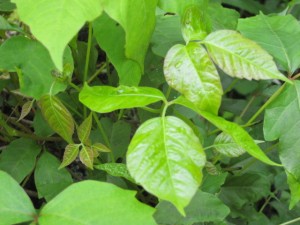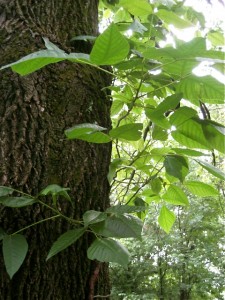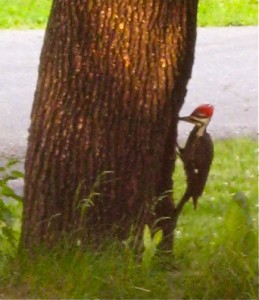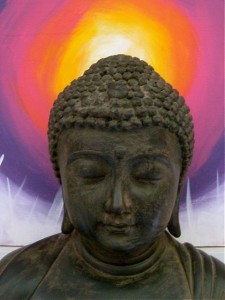We can’t stop nature from doing what it will and so we must learn to flow with it, to take action to protect ourselves within our knowledge of how nature works. On the other hand, we are responsible for what is happening in nature now. Although we are not directly responsible for thunderstorms, lightning strikes, tornadoes, hurricanes, earthquakes, etc., there is plenty that we, the human race, have, by our very existence, altered forever on this planet. One of those things is poison ivy.

Several years ago, I heard a report on NPR about the proliferation of a new strain of poison ivy. This strain, I heard, was more potent than the kind of poison ivy I remember as a kid. This new strain of poison ivy grew into trees, as tall as six or ten feet, and it could kill. Now that was alarming to hear!
Having grown up in a rural environment, I learned early what poison ivy looked like. I knew its reddish hue in the spring meant beware, and I also knew that its bright green leaves later in the summer meant stay away. I had an eye for identifying plants early in life—it was just a knack. I knew to stay away from the flowers and berries of deadly nightshade from the time I was small and I’d often warn my friends that something was dangerous without even knowing how I knew it. I’d thought about becoming a botanist at one time, so fond and curious was I of what grew around me. Instead I became an illustrator and did, on many an occasion, get to draw the intricacies of the plant world for one book or magazine article or another.
If I got poison ivy, it was normally a minimal rash, easily dealt with. I never got covered like some people. I didn’t seem especially allergic to it, though I knew not to fool with it either, not to rub it or scratch, but to wash the oils off as soon as possible and let it dry out. I’d cover it with calamine and let it be and before long it would dry up without too much discomfort. I remember as a little kid having it on my face and at the time I just could not help but scratch, and boy did I suffer, but that also taught me a lesson. After that I learned to bear the tension of the itch and just get through the pain that nature itself had inflicted on me, knowing that it would soon be gone. That being said, even I was recently fooled.
One morning, Chuck and I were sitting in the yard enjoying a cup of coffee when I felt an itch. Thinking a bug was crawling up my arm, I lifted my sleeve to discover that my entire arm was covered in an ugly rash. “Oh my, look at that! Poison ivy! Where did that come from? I’m usually so careful!” I said. By the afternoon it had spread. Another, less vicious looking rash showed up on my other arm, my stomach broke out in angry red spots. Later an itch on the back of my neck showed up, another behind my ear, and was that one by my eye too? Suffice it to say, I had a bad case of poison ivy.
“This is exactly what I’d heard about years ago,” I said to Chuck, “poison ivy in a new, especially toxic strain, and it looks like I have it!”

In reading up on that new strain of poison ivy, I note that in the few years since I first heard about it, its notoriety has spread along with it. Now it’s certain that we are largely responsible for this new potent strain of poison ivy, and there is no longer just one new potent strain, but many. The vines are rapidly spreading and the resulting contact itch much more difficult to treat.
With global warming has come an increase in carbon dioxide in the atmosphere, a trapped greenhouse gas that is especially well liked by vines, especially the two that we see in the Northeast: Virginia creeper and poison ivy. That’s another thing I noticed not long ago. When I was a kid, Virginia creeper did just that, it crept along the ground, the floor of the forests covered with it, but I rarely saw it climbing trees the way it does now. Now both Virginia creeper and poison ivy, along with a host of other carbon dioxide-loving vines, are climbing higher and higher, overtaking other vegetation, seriously affecting the survival of our forests. Apparently this new poison ivy—that is rapidly inhaling our humanly-induced increase in carbon dioxide—carries a more toxic form of urushiol, the oil that causes the pesky itch.
As soon as I saw how quickly the rash was spreading, I knew I was in trouble. This was no ordinary case of poison ivy, this is what I saw on other people who were highly allergic, this was serious. I took immediate action. Changing my clothes, showering, and dousing myself with calamine and taking homeopathic rhus-tox were the first steps. Careful not to aggravate it, I let the rash air dry as much as possible, but it got worse. And then it got even worse. Now covered in angry blisters, I constantly had to fight the urge to scratch.
Now, anyone who has had poison ivy knows that there is nothing more satisfying than giving in to the urge to scratch away. Boy does that feel good! On the other hand, no amount of scratching will ever relieve the suffering, as scratching only spreads the rash and calls for yet more scratching.

I found some relief in showering frequently, vicariously experiencing itch relief by letting the hot spiky water from the shower head do the scratching for me. I soon found that this was not a good idea, the heat of the water actually opening my pores to more of the poison. I knew I had to “grin and bear it,” as they say. I would not scratch in any way. I would use the itchiness to go into stillness. And so began my week of deepening my mindfulness practice, with poison ivy as my guide. In so doing, I learned something new about myself and each time I learned something new I took it deeper, intent on learning something else, not only about myself, but also about the greater world that I live in.
I’d wake up at night itchy. Surely a tiny little scratch here or there won’t hurt? Don’t do it! Bear the tension. Let it be. Go into meditation. Go beyond the skin. Go deeper inside. I will not scratch because I do not itch. I do not feel itchy at all. I am the Buddha. Flies are landing on my face and yet I do not flinch. I am the Buddha. Mosquitoes are buzzing in my eyes and yet I simply ignore them. I do not give them any energy. I am the Buddha. The snake is coming closer in the grass and yet I am not afraid. I sit in stillness and I disappear. I am the Buddha. In stillness I do not exist in this body. I am merely energy and thus the sensations of this body are meaningless. I can let them go.
I gradually leave my itchy body behind as I do this mindfulness practice, successfully removing myself from it enough as the night goes on that eventually I don’t attach. In the morning I wake up tired, but I have succeeded in avoiding the deathtrap, the itchiness that invites me to partake in the vicious cycle of relief and more agony, relief and more agony. I avoid the cycle of samsara, suffering, for one more night. And I must continue this practice during the day as well. I must not lift my hand to scratch behind my ear. I am the Buddha. I must leave my hand down, sit with the sensation, detaching from it, cooling it with my thoughts at the same time that I seek external remedies for my suffering.

I suffer through five days of extreme discomfort before the rash subsides. Chuck looks at it one day and declares it done. I’ve conquered it. There is still an occasional itchiness, but the blisters have dried, the redness has diminished, the spread halted. I have learned what it means to suffer through an onslaught of nature, a manmade disaster as I now see it, and I hope that others may come through such an attack in good form too.
My mindfulness practice with poison ivy as my guide led me many places, to many journeys within and without, to greater understanding and acceptance of my role as a user on this planet. The world is changing and we are largely responsible for many of these changes. That is clear to me now. Every one of us, by our very breathing, effect and are affected by these changes. Whether it’s a bad case of poison ivy or a nuclear disaster like Fukushima, we are all part of the problem and we will all suffer, our bodies especially.
I had to ask some hard questions. So, how are we going to handle the inevitable crisis we have inflicted on ourselves? Are we going to make it worse by scratching and complaining about others, about the poisons put into our atmosphere by others? It’s easy to give up, to indulge in bad behaviors, to wallow in self-pity and to blame. It’s much harder to take full responsibility and change ourselves.
The challenge we face now is to accept what our human greed has done and—in full knowledge of our personal participation in the disasters we create and continue to create—take everything to a new level. We must accept our human limitations and work to deepen our connection to our energetic selves, personally and as an interconnected species, taking everything far beyond the human energy that we so value and indulge in to a greater understanding of our energy as no different than that of the fly or the mosquito that pesters us. We are all life’s energy having experiences here on earth.
Everyday now, I accept that I am part of the changing world. My mindfulness practice has deepened my awareness of what it means that I live here too, that I impact everything too. I too have poisoned the fish in the ocean. I too have dirtied the waters and contaminated the soil. I too have contributed to the greenhouse gases. I too am responsible for the wars and the terrible massacres that are happening around the globe. I too am an abuser. I too am greedy. I too am an addict.
I cannot change what has happened. It has already happened. The only thing I can do now is, from this moment on, make a decision to live my life differently, with awareness and mindfulness, committed to making better personal choices. The time of change is now. 2012 is upon us and, by the potent state of things, has been for a long time. Are we going to stay splintered, unaccepting of our personal human role in all of this that we have created? Or are we going to each individually take the next step to deepening our interconnected awareness and really changing ourselves so that we may change our world too? That’s the only challenge I see ahead of us now.
The earth will survive, but I don’t think we, as a species, will—unless we take some drastic measures to insure that our planet will be able to support us. With even the most basic requirements of air and water in jeopardy, let alone everything else we need to survive in even the most primitive conditions, how do we expect to evolve as a species?
I challenge myself to constantly create better balance in my own life while seeking to live in greater harmony with the world I find myself in.
In humbleness,
Jan
